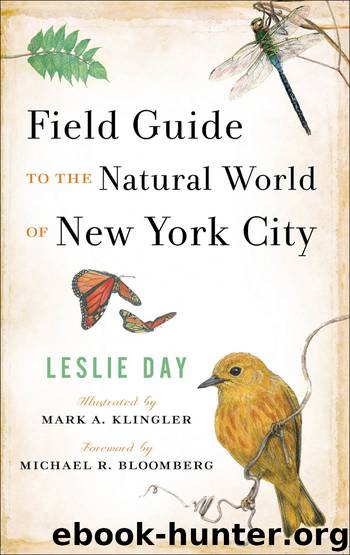Field Guide to the Natural World of New York City by Leslie Day

Author:Leslie Day
Language: eng
Format: epub
Publisher: Johns Hopkins University Press
Published: 2007-03-18T16:00:00+00:00
Plate 24 DIAMONDBACK TERRAPIN
• Since human disturbance can prevent females from nesting, the best way to view terrapins is with binoculars from 150 feet.
Eastern Painted Turtle: Chrysemys picta picta
ETYMOLOGY
Chrysemys: yellow turtle; picta: painted, embroidered
Description The native eastern painted turtle is beautifully patterned. Up to 9 inches long, their greenish black carapace (upper shell) is flat and smooth with yellow lines between the scutes (scales). The carapace is bordered with red markings, and the plastron (lower shell) is yellow. The greenish black face is covered with broad, yellow stripes with yellow spots behind the eyes. The neck, legs, and tail have yellow and red stripes.
Common Locations The eastern painted turtle can be found in freshwater ponds and lakes throughout the five boroughs of the city.
Notes of Interest Eastern painted turtles prefer water bodies with aquatic plants for food and shelter, and logs and rocks that they can climb out on to bask. Sitting in the sun helps them digest food, warm their muscles, and rid themselves of parasites such as leeches, which dry up in the sun. Sometimes painted turtles bask with other turtles, such as the red-eared slider, and several turtles may sit on top of one another on logs or rocks. If the turtles sense danger they quickly escape into the water. In spring and summer, females dig nests on the shore and lay their eggs. Some hatchlings may overwinter in the nest and emerge the following spring. As with some other turtles and snakes, the gender of the hatchling is determined by temperature. Warm temperatures produce females and cooler temperatures produce males.
Ecological Role The eastern painted turtle is an omnivore, consuming aquatic plants such as duckweed, algae, and water lilies, along with earthworms, insects, leeches, snails, crayfish, fish, tadpoles, frogs, and carrion (dead animals). Predators of the eastern painted turtle, especially juveniles, include fish, bullfrogs, turtles, snakes, herons, hawks, crows, raccoons, and foxes.
KEY POINTS
• Eastern painted turtles are colorful, with bright yellow stripes on their heads and red markings along the border of their carapace.
• Look for them basking on rocks and logs in city ponds and lakes.
Download
This site does not store any files on its server. We only index and link to content provided by other sites. Please contact the content providers to delete copyright contents if any and email us, we'll remove relevant links or contents immediately.
Sapiens: A Brief History of Humankind by Yuval Noah Harari(14248)
The Tidewater Tales by John Barth(12608)
Mastermind: How to Think Like Sherlock Holmes by Maria Konnikova(7225)
Do No Harm Stories of Life, Death and Brain Surgery by Henry Marsh(6887)
The Thirst by Nesbo Jo(6826)
Why We Sleep: Unlocking the Power of Sleep and Dreams by Matthew Walker(6618)
Life 3.0: Being Human in the Age of Artificial Intelligence by Tegmark Max(5474)
Sapiens by Yuval Noah Harari(5293)
The Longevity Diet by Valter Longo(5017)
The Body: A Guide for Occupants by Bill Bryson(4974)
The Rules Do Not Apply by Ariel Levy(4852)
The Immortal Life of Henrietta Lacks by Rebecca Skloot(4525)
Animal Frequency by Melissa Alvarez(4394)
Why We Sleep by Matthew Walker(4359)
The Hacking of the American Mind by Robert H. Lustig(4318)
Yoga Anatomy by Kaminoff Leslie(4303)
All Creatures Great and Small by James Herriot(4231)
Double Down (Diary of a Wimpy Kid Book 11) by Jeff Kinney(4206)
Barron's AP Biology by Goldberg M.S. Deborah T(4096)
